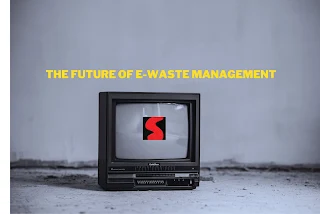E-waste must go through several processes before becoming recyclable, which requires input from manufacturers, consumers and collectors alike.
 |
| E- waste |
E-waste disposal presents an acute challenge that must be solved immediately as its toxic chemicals can pollute our soil and water systems, harming plants and animals in the process.
Artificial Intelligence
The world needs a way to address the enormous amounts of electronic waste being produced each day, with technology and a shift towards circular economies providing solutions. By working together on this effort we can reduce waste generation while creating a more sustainable future. However, this will require effort and cooperation from all involved - corporations, consumers, local government.
One area in which artificial intelligence could prove invaluable is in sorting and recycling e-waste. E-waste challenges stem from improper sorting and disassembly processes; electronic devices often remain difficult to disassemble due to manufacturers designing them to discourage tampering; however, AI and robots could make this task far simpler; disassembling electronics requires time-consuming manual efforts; with automation techniques making disassemble timelier, valuable components could be salvaged for reuse and salvaged from landfill.
At present, technologies like waste recognition and sorting systems, AI for quality control, and facility monitoring technologies may help electronics manufacturers reduce e-waste pollution, saving billions while eliminating pollution altogether.
To combat e-waste, big businesses and consumers must recycle as much as possible. One effective solution for doing this is Pello technology which utilizes waste metering sensors to track bin contents real time, thereby alerting maintenance managers when trash has entered recycling bins - this enables only trucks that need dispatching to be dispatched when absolutely necessary - thus reducing emissions while cutting costs.
Machine Learning
E-waste problems are escalating rapidly. Recycling as much technology as possible rather than simply throwing it out can be tricky when devices are constructed so as to be hard to open and disassemble, yet necessary for survival.
Machine learning could help address this e-waste challenge by identifying recyclable materials and segregating them from contaminants, potentially reducing costs associated with recycling by making it simpler to sort through various parts of a device.
AI can be utilized to quickly identify and de-manufacture components of devices, saving time and money through reduced manual labor requirements. In doing so, AI helps reduce virgin material demand as well as environmental impacts associated with mining operations.
Current E-Waste management involves collecting and processing waste from various locations before turning it into usable energy or metal for production purposes. Unfortunately, this method of managing electronic waste can be both time consuming and expensive while harming the environment; to improve its management we must find innovative new methods of processing electronic waste.
One solution is using an incineration system that can convert waste to usable energy and metals without producing harmful fumes, in a controlled environment reducing labor requirements and risk exposure to health hazards for workers. A second possibility would be using new robotic technology that can identify and dismantle devices to make recycling simpler.
Repair Culture
E-waste management employs the 3Rs approach: reduce, reuse, and recycle. This strategy can help lessen pressure on finite primary resources like metal ores that may soon run out; however, improper recycling of e-waste may pose significant problems; for instance if batteries are improperly disposed of they could release harmful substances into the environment that threaten both human health and environmental sustainability; improper disposal can also cause soil contamination, water contamination, as well as air pollution.
One way to enhance e-waste management is by encouraging repairability of electronics. This can be achieved either through supporting local repair businesses, or legislation encouraging manufacturers to design products with repairability in mind. Recently, the European Union included repairability rights as part of two key policies on sustainable production and consumption, marking an important step toward circular economy.
Develop and implement new technologies to advance e-waste management in the future, such as easier to recycle materials or energy-efficient manufacturing techniques. Furthermore, encourage more recycling facilities to open so as to provide jobs and income to local communities. Finally, we should promote repair-focused cultures as these can help combat planned obsolescence which involves designing products specifically so they become outdated quickly and lead to even more waste.
Recyclable Materials
E-waste generation rates are on an exponentially upward trajectory worldwide due to technological progress, shorter product lifespans, and shifting consumer demands. More OEMs are setting circularity targets requiring them to use recycled materials in their products, with recycling e-waste being an effective means of meeting this target.
E-waste recycling can be challenging. Limited domestic processing capacity and commodity price fluctuations have limited progress; limited recyclers have taken on larger volumes while it makes investments necessary to extracting metals more effectively from e-waste streams more challenging.
E-wastes also contain harmful materials, including heavy metals (cadmium, lead and mercury), polycyclic aromatic hydrocarbons and polybrominated diphenyl ethers that can pollute air, water and soil if mishandled improperly; such emissions can pollute air quality, cause environmental contamination or pose threats to human and animal life (Awasthi et al. 2016).
Technology offers some relief by improving e-waste management and increasing raw material recovery rates. Value recovery rebates and long-term contracts, for instance, can increase collection of e-waste by providing secure cashflow for recyclers while offering secure feedstock to material processors and OEMs.












No comments:
Post a Comment